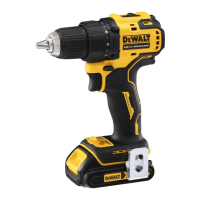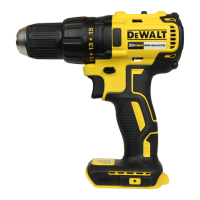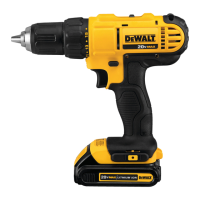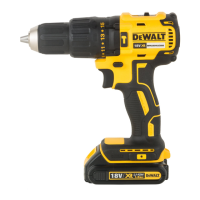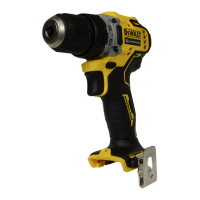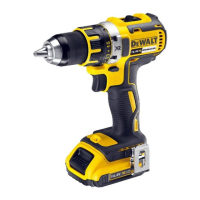10
ENGLISH
NOTE: The worklight is for lighting the immediate work surface
and is not intended to be used as aflashlight.
Torque Adjustment Collar (Fig. A)
The torque adjustment collar
3
is clearly marked with numbers
and a drill bit symbol.The collar should be rotated until the
desired setting is located at the top of the tool. Locators are
provided in the collar to eliminate the guess work when
selecting fastening torque. The higher the number on the collar,
the higher the torque and the larger the fastener which can be
driven. To lock the clutch for drilling operations, move to the drill
bitposition.
NOTE: When using the drill/driver for drilling holes, be sure
that the torque adjusting collar is set so the figure of the drill is
aligned with the center line on the top of the tool. Failure to do
this will allow the clutch to slip while attempting todrill.
Dual Range Gearing (Fig. A, D)
The dual range feature of your driver/drill allows you to shift
gears for greaterversatility.
To select the low speed, high torque setting, turn the tool off
and permit to stop. Slide the gear shifter
4
forward (towards
the chuck). To select the high speed, low torque setting, turn
the tool off and permit to stop. Slide the gear shifter back (away
from chuck).
NOTE: Do not change gears when the tool is running. If you are
having trouble changing gears, make sure that the dual range
gear shifter is either completely pushed forward or completely
pushedback.
Keyless Single Sleeve Chuck (Fig. E)
Your tool features a keyless chuck with one rotating sleeve for
one-handed operation of the chuck. To insert a drill bit or other
accessory, follow thesesteps.
1. Lock the trigger in the OFF position as previouslydescribed.
2. Grasp the black sleeve of the chuck with one hand
and use the other hand to secure the tool. Rotate the
sleeve counterclockwise far enough to accept the
desiredaccessory.
3. Insert the accessory about 19mm into the chuck and
tighten securely by rotating the chuck sleeve clockwise with
one hand while holding the tool with the other. Your tool is
equipped with an automatic spindle lock mechanism. This
allows you to open and close the chuck with onehand.
To release the accessory, repeat step 2above.
WARNING: Do not attempt to tighten drill bits (or any
other accessory) by gripping the front part of the chuck
and turning the tool on. Damage to the chuck and
personal injury may result. Always lock off trigger switch
when changingacces sories.
Be sure to tighten chuck with one hand on the chuck sleeve and
one hand holding the tool for maximumtightness.
Chuck Removal (Fig.F)
Turn the adjustment collar to the “drill” position and gear shifter
to position 1 (low speed). Tighten the chuck around the shorter
end of a hex key (not supplied) of 6.35 mm or greater size. Using
a wooden mallet or similar object, strike the longer end in the
clockwise direction, as shown. This will loosen the screw inside
thechuck.
Open chuck jaws fully, insert screwdriver (or Torx tool if
required) into front of chuck between jaws to engage screw
head. Remove screw by turning clockwise (left-hand-thread).
Place hex key in chuck and tighten, as shown in FigureF. Using
a wooden mallet or similar object, strike key sharply in the
counterclockwise direction. This will loosen the chuck so that it
can be unscrewed byhand.
Chuck Installation (Fig.G)
Screw the chuck on by hand as far as it will go and insert screw
(left-hand thread). Tighten screw securely. Tighten the chuck
around the shorter end of a 6.35 mm or larger hex key (not
supplied) strike the longer end in the clockwise direction with
a wooden mallet, as shown. Tighten the screw once again by
turning in a counterclockwisedirection.
Drill Operation
WARNING: To reduce the risk of serious personal injury,
turn tool off and disconnect tool from power source
before making any adjustments or removing/installing
attachments oraccessories.
WARNING: To reduce the risk of personal injury,
ALWAYS ensure workpiece is anchored or clamped firmly.
If drilling thin material, use a wood “back-up” block to
prevent damage to thematerial.
Turn the collar to the drill bit symbol for drilling. Select the
desired speed/torque range using the gear shifter to match the
speed and torque to the plannedoperation.
1. Use sharp drill bits only. For WOOD, use twist drill bits, spade
bits, or hole saws. For METAL, use high-speed steel (HHS)
twist drill bits or holesaws.
2. Always apply pressure in a straight line with the bit. Use
enough pressure to keep drill biting, but do not push hard
enough to stall the motor or deflect thebit.
3. Hold tool firmly with both hands to control the twisting
action of thedrill.
WARNING: The drill may stall if overloaded causing a
sudden twist. Always expect the stall. Grip the drill firmly
with both hands to control the twisting action and
avoidinjury.
4. IF DRILL STALLS, it is usually because it is being overloaded
or improperly used. RELEASE TRIGGER IMMEDIATELY,
remove drill bit from work, and determine cause of stalling.
DO NOT CLICK TRIGGER ON AND OFF IN AN ATTEMPT
TO START A STALLED DRILL — THIS CAN DAMAGE
THEDRILL.
5. To minimize stalling or breaking through the material,
reduce pressure on drill and ease the bit through the last
fractional part of thehole.
6. Keep the motor running when pulling the bit back out of a
drilled hole. This will help preventjamming.
7. With variable speed drills there is no need to center punch
the point to be drilled. Use a slow speed to start the hole
